Inside the Bryce Gibbs trade: How neither Adelaide or Carlton were winners from the 2017 deal
It was a much publicised deal that came through after a failed attempt. But seven years on, it’s fair to say the winners of the Bryce Gibbs trade weren’t Adelaide or Carlton.
AFL
Don't miss out on the headlines from AFL. Followed categories will be added to My News.
Carlton and Adelaide will face off at Marvel Stadium on Saturday but it is three other clubs who are reaping the rewards of the Bryce Gibbs trade seven years on.
After a false start the year before, Gibbs finally got his move from the Blues to the Crows in the 2017 trade period, joining an Adelaide side that weeks earlier had led halfway through the second quarter in the grand final.
But the Crows began to disintegrate that summer after their infamous pre-season camp and, while Gibbs had a good 2018 season personally, his new club missed the finals and he found himself playing SANFL in 2019.
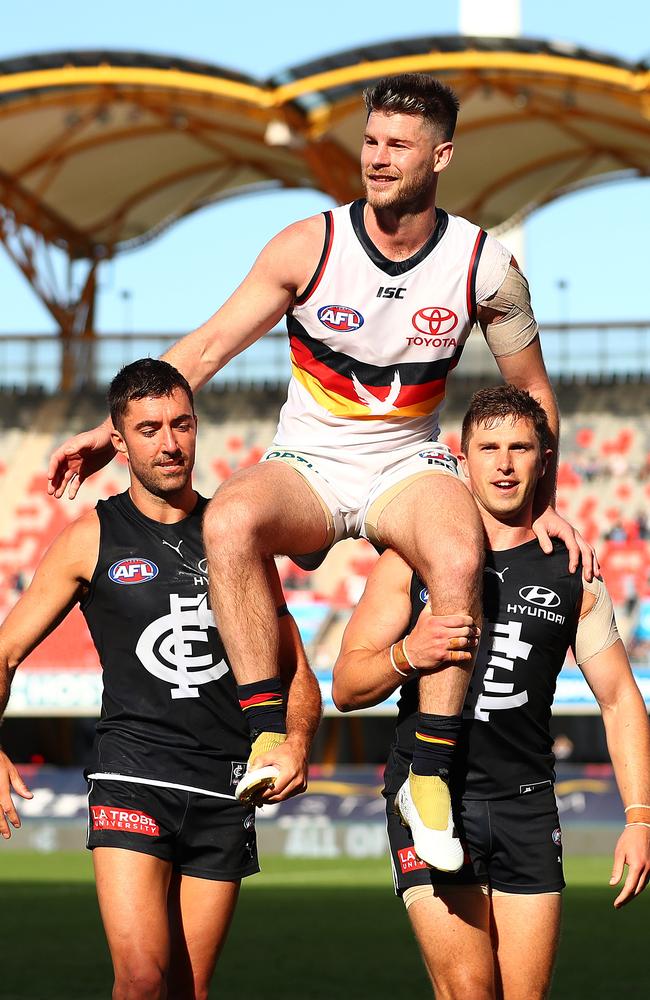
Most thought the Blues had won the trade, by landing two first-round picks in the deal for a player who never made an All-Australian side.
The first was used on Lochie O’Brien, who was delisted last year after 66 games and the second was used on a bright talent who is playing at a rival club.
Adelaide won two future picks off Carlton in the Gibbs trade, both of which ended up sent elsewhere and used by the Sydney clubs on players who have more consequence in 2024 than anything the Blues or Crows received.
THE UNINTENDED WINNERS
Watch Collingwood, Sydney or the Western Bulldogs and you see the jewels of the Gibbs trade.
Carlton used pick 10 on O’Brien, a player some recruiters at the time wouldn’t have looked at through the entire national draft.
Another hard-running left footer was seen by the Bulldogs as a huge chance to go with that pick but instead Ed Richards was left on the board.
Those at Ikon Park were somewhat spooked that Richards had rocked up 45 minutes late to a pre-draft meeting.
But the Dogs were later convinced he had just had car trouble and landed him at No.16, after earlier taking Aaron Naughton.
“From speaking to teachers who have known him for five years, his character and his punctuality have been of the highest order,” then Dogs recruiter Simon Dalrymple said at the time.
That pick ended up at the Whitten Oval because of a trade made after the Gibbs move, in which the Blues swapped picks 16 and 40 for the Dogs’ 28, 30 and a future second-rounder.

The only real winning move of the Gibbs saga for Carlton came from that deal, with Carlton using No.30 on budding ruck star Tom De Koning.
That 2017 draft hit its stride in the second round, when Tim Kelly, Noah Balta, Liam Ryan, Brent Daniels, Sam Taylor, Charlie Spargo, De Koning and Bayley Fritsch were taken with consecutive picks starting at No.24.
Between the Blues taking O’Brien at No.10 and Richards being called at 16 were the names Aiden Bonar, Darcy Fogarty, Jarrod Brander, Matt Ling and Zac Bailey.
Pick 28 ended with the Giants in exchange for Matt Kennedy.
The Giants used it on arguably the best defender in the land – full-back Taylor.
The GWS tentacles on the Gibbs trade don’t end there.
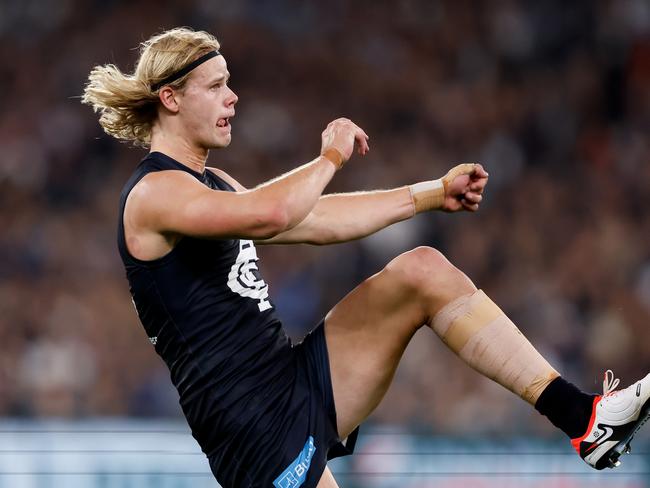
In the 2018 trade period, the Giants swapped that year’s pick 28 – the second-round selection won by the Crows as filler in the Gibbs deal – and a future second for pick 24 and a future fifth.
Adelaide used pick 28 on Will Hamill, who has played 38 games and was delisted and re-rookied last year.
That future fifth was never going to be used by GWS, but the Giants spent No.24 on Bobby Hill, who won last year’s Norm Smith Medal at Collingwood.
Cross-town rivals Sydney ended up with the other future pick that Adelaide gained from the Gibbs deal in a three-team swap that sent Mitch McGovern to Carlton.
The Swans used that pick, which became No.40 in 2018, on solid midfielder Justin McInerney.
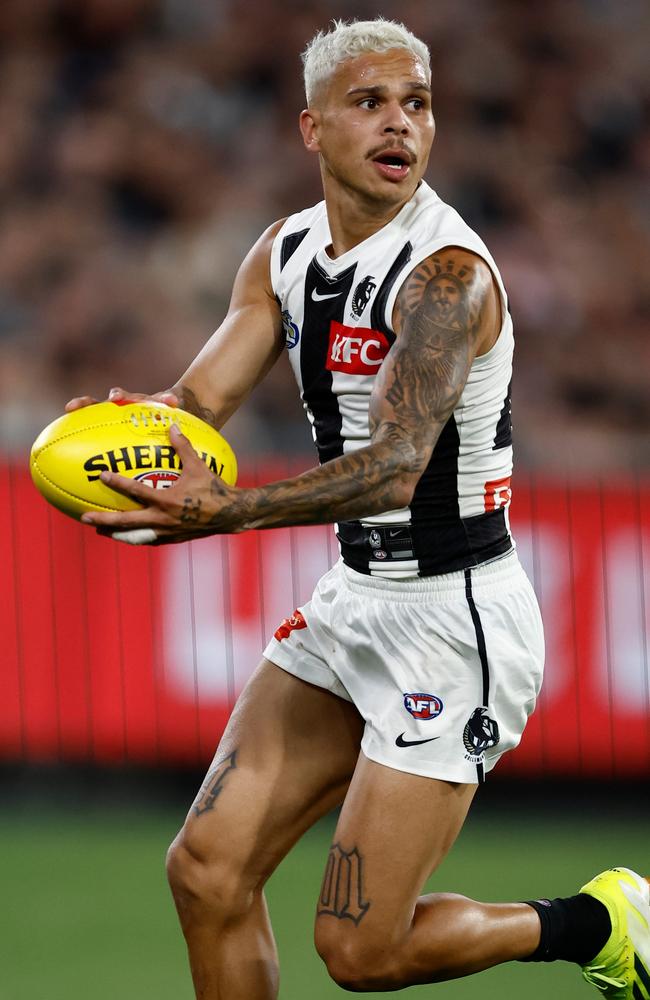
And the future second that Carlton got from the Gibbs swap?
That eventually became James Jordon, who Melbourne sent to Sydney this off-season and will play significant minutes alongside McInerney in the Swans midfield.
Aside from O’Brien, Carlton used pick 70 directly from the Gibbs swap on Angus Schumacher, who played one game in the navy blue.
The direct results of the 2017 trade played just over 100 games combined for Carlton and Adelaide, while the picks that became players at other clubs appear on track to at least triple that amount.
THE BRYCE OF THE TRADE
How things could have been different if the plug wasn’t pulled a year earlier.
Gibbs initially requested a trade home to Adelaide at the end of the 2016 season and boarded a flight to New Zealand hoping it would be done.
But he landed on the other side of the ditch with teammate Dale Thomas shaking his head that it didn’t get over the line.
He was in the midst of a five-year contract that expired in 2019 and Adelaide winced at the high asking price Carlton put on the table.
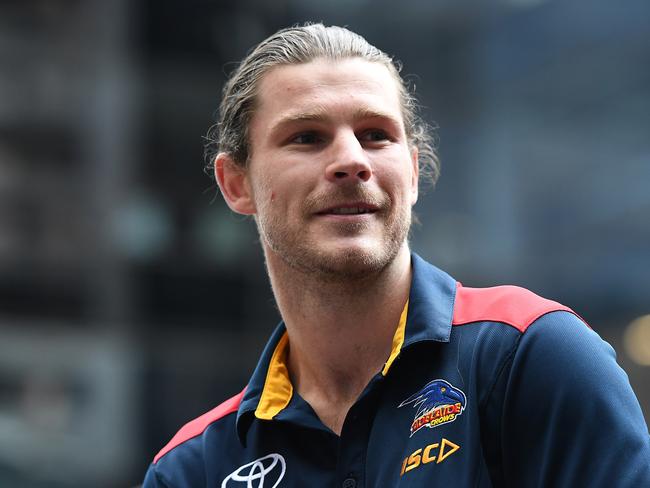
The Crows dominated much of 2017 before being overrun by Richmond in the season decider.
Gibbs played five finals in his 231 games at Carlton and the 2017 trade period was a final throw at the stumps.
“If it hadn’t happened (in 2017) I think it’s fair to say I wasn’t going to go back and ask a third time to come home,” he said post-trade.
The final deal initially fell over during trade period, when a misunderstanding between the two clubs over a future draft pick saw a discrepancy when the papers were lodged with the AFL.
After a heated meeting that lasted several hours, the 2006 No.1 pick eventually went from a success-starved Carlton to a club that was about to blow itself up with that pre-season camp.
New on the scene that summer, Gibbs later said the camp “did fracture the playing group, it fractured relationships in the football department” and that he likely would have played more games in Crows colours if it never happened.
Alas, that camp did happen, but the 2018 season was far from a disaster for Gibbs on-field.
He hit a career mark for metres gained, averaged 25.9 touches a game and polled nine Brownlow votes.
The Crows tumbled out of the final eight but Gibbs still won 12 games, the second-highest mark of his 14-year career.
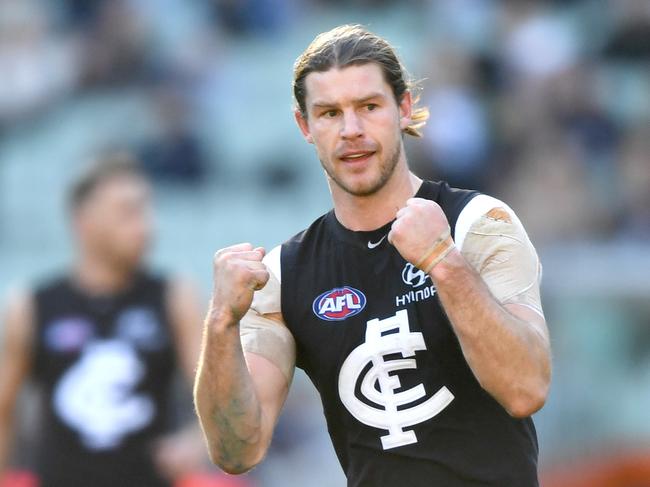
Carlton finished 2018 dead last.
By mid-2020 it was all over, as Gibbs was largely relegated to the SANFL and he retired during the Covid season, having played 37 games at his second club.
He won the Magarey Medal as the best SANFL player in 2021.
“The last couple of years haven’t gone the way I thought they would’ve. More specifically the last two years,” he said when he retired.
“It’s funny how things work … things don’t work out for you but it opens up other doors going forward.”
Unfortunately for the Blues and Crows, the doors opened by the Gibbs trade were almost all for rival clubs.
More Coverage
Originally published as Inside the Bryce Gibbs trade: How neither Adelaide or Carlton were winners from the 2017 deal





